tow Lancia Musa 2010 Owner handbook (in English)
[x] Cancel search | Manufacturer: LANCIA, Model Year: 2010, Model line: Musa, Model: Lancia Musa 2010Pages: 218, PDF Size: 3.71 MB
Page 114 of 218

113
WARNING
LIGHTS AND
MESSAGES
IN AN
EMERGENCY
MAINTENANCE
AND CARE
TECHNICAL
SPECIFICA-
TIONS
INDEX
DASHBOARD
AND
CONTROLS
SAFETY
STARTING
AND DRIVING
STARTING AND DRIVING
STARTING THE ENGINE................................ 114
PARKING THE VEHICLE ................................ 116
USING THE MECHANICAL GEARBOX............ 117
CONTAINING RUNNING COSTS ..................... 118
TOWING TRAILERS ........................................ 119
SNOW TYRES .................................................. 122
SNOW CHAINS ................................................ 123
CAR INACTIVITY ............................................ 124
Page 116 of 218
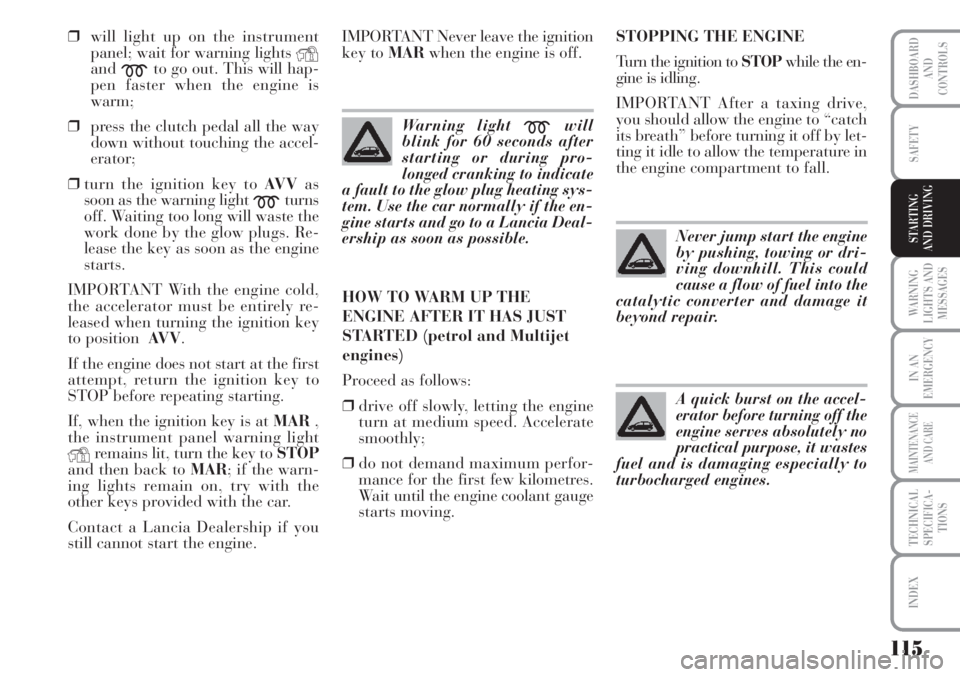
115
WARNING
LIGHTS AND
MESSAGES
IN AN
EMERGENCY
MAINTENANCE
AND CARE
TECHNICAL
SPECIFICA-
TIONS
INDEX
DASHBOARD
AND
CONTROLS
SAFETY
STARTING
AND DRIVING
❒will light up on the instrument
panel; wait for warning lights
Yand
mto go out. This will hap-
pen faster when the engine is
warm;
❒press the clutch pedal all the way
down without touching the accel-
erator;
❒turn the ignition key to AV Vas
soon as the warning light
mturns
off. Waiting too long will waste the
work done by the glow plugs. Re-
lease the key as soon as the engine
starts.
IMPORTANT With the engine cold,
the accelerator must be entirely re-
leased when turning the ignition key
to position AV V.
If the engine does not start at the first
attempt, return the ignition key to
STOP before repeating starting.
If, when the ignition key is at MAR,
the instrument panel warning light
Yremains lit, turn the key to STOP
and then back to MAR; if the warn-
ing lights remain on, try with the
other keys provided with the car.
Contact a Lancia Dealership if you
still cannot start the engine.HOW TO WARM UP THE
ENGINE AFTER IT HAS JUST
STARTED (petrol and Multijet
engines)
Proceed as follows:
❒drive off slowly, letting the engine
turn at medium speed. Accelerate
smoothly;
❒do not demand maximum perfor-
mance for the first few kilometres.
Wait until the engine coolant gauge
starts moving.Warning light
mwill
blink for 60 seconds after
starting or during pro-
longed cranking to indicate
a fault to the glow plug heating sys-
tem. Use the car normally if the en-
gine starts and go to a Lancia Deal-
ership as soon as possible.
STOPPING THE ENGINE
Turn the ignition to STOPwhile the en-
gine is idling.
IMPORTANT After a taxing drive,
you should allow the engine to “catch
its breath” before turning it off by let-
ting it idle to allow the temperature in
the engine compartment to fall.
Never jump start the engine
by pushing, towing or dri-
ving downhill. This could
cause a flow of fuel into the
catalytic converter and damage it
beyond repair.
A quick burst on the accel-
erator before turning off the
engine serves absolutely no
practical purpose, it wastes
fuel and is damaging especially to
turbocharged engines.
IMPORTANT Never leave the ignition
key to MARwhen the engine is off.
Page 118 of 218
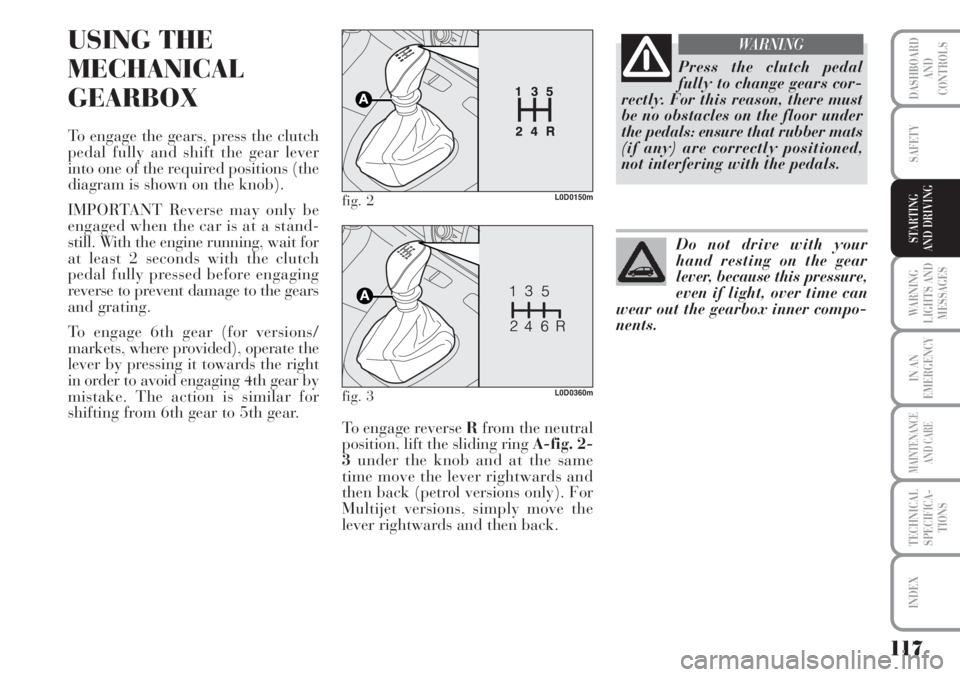
117
WARNING
LIGHTS AND
MESSAGES
IN AN
EMERGENCY
MAINTENANCE
AND CARE
TECHNICAL
SPECIFICA-
TIONS
INDEX
DASHBOARD
AND
CONTROLS
SAFETY
STARTING
AND DRIVING
USING THE
MECHANICAL
GEARBOX
To engage the gears, press the clutch
pedal fully and shift the gear lever
into one of the required positions (the
diagram is shown on the knob).
IMPORTANT Reverse may only be
engaged when the car is at a stand-
still. With the engine running, wait for
at least 2 seconds with the clutch
pedal fully pressed before engaging
reverse to prevent damage to the gears
and grating.
To engage 6th gear (for versions/
markets, where provided), operate the
lever by pressing it towards the right
in order to avoid engaging 4th gear by
mistake. The action is similar for
shifting from 6th gear to 5th gear.
To engage reverse Rfrom the neutral
position, lift the sliding ring A-fig. 2-
3under the knob and at the same
time move the lever rightwards and
then back (petrol versions only). For
Multijet versions, simply move the
lever rightwards and then back.
fig. 2L0D0150m
fig. 3L0D0360m
Do not drive with your
hand resting on the gear
lever, because this pressure,
even if light, over time can
wear out the gearbox inner compo-
nents.
Press the clutch pedal
fully to change gears cor-
rectly. For this reason, there must
be no obstacles on the floor under
the pedals: ensure that rubber mats
(if any) are correctly positioned,
not interfering with the pedals.
WARNING
Page 119 of 218
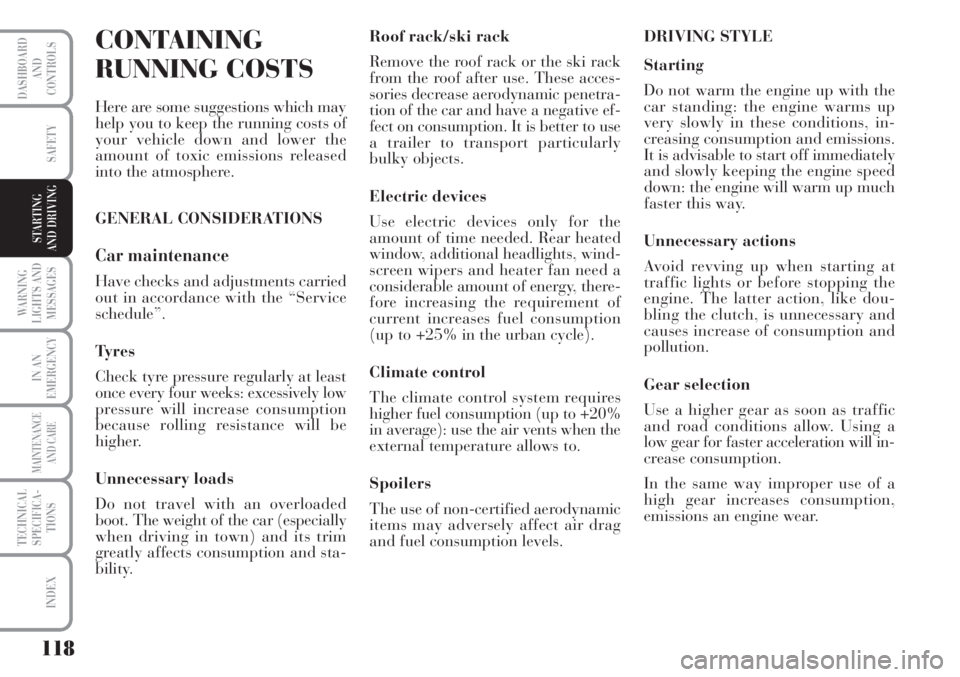
118
WARNING
LIGHTS AND
MESSAGES
IN AN
EMERGENCY
MAINTENANCE
AND CARE
TECHNICAL
SPECIFICA-
TIONS
INDEX
DASHBOARD
AND
CONTROLS
SAFETY
STARTING
AND DRIVING
CONTAINING
RUNNING COSTS
Here are some suggestions which may
help you to keep the running costs of
your vehicle down and lower the
amount of toxic emissions released
into the atmosphere.
GENERAL CONSIDERATIONS
Car maintenance
Have checks and adjustments carried
out in accordance with the “Service
schedule”.
Ty r e s
Check tyre pressure regularly at least
once every four weeks: excessively low
pressure will increase consumption
because rolling resistance will be
higher.
Unnecessary loads
Do not travel with an overloaded
boot. The weight of the car (especially
when driving in town) and its trim
greatly affects consumption and sta-
bility.Roof rack/ski rack
Remove the roof rack or the ski rack
from the roof after use. These acces-
sories decrease aerodynamic penetra-
tion of the car and have a negative ef-
fect on consumption. It is better to use
a trailer to transport particularly
bulky objects.
Electric devices
Use electric devices only for the
amount of time needed. Rear heated
window, additional headlights, wind-
screen wipers and heater fan need a
considerable amount of energy, there-
fore increasing the requirement of
current increases fuel consumption
(up to +25% in the urban cycle).
Climate control
The climate control system requires
higher fuel consumption (up to +20%
in average): use the air vents when the
external temperature allows to.
Spoilers
The use of non-certified aerodynamic
items may adversely affect air drag
and fuel consumption levels.DRIVING STYLE
Starting
Do not warm the engine up with the
car standing: the engine warms up
very slowly in these conditions, in-
creasing consumption and emissions.
It is advisable to start off immediately
and slowly keeping the engine speed
down: the engine will warm up much
faster this way.
Unnecessary actions
Avoid revving up when starting at
traffic lights or before stopping the
engine. The latter action, like dou-
bling the clutch, is unnecessary and
causes increase of consumption and
pollution.
Gear selection
Use a higher gear as soon as traffic
and road conditions allow. Using a
low gear for faster acceleration will in-
crease consumption.
In the same way improper use of a
high gear increases consumption,
emissions an engine wear.
Page 120 of 218
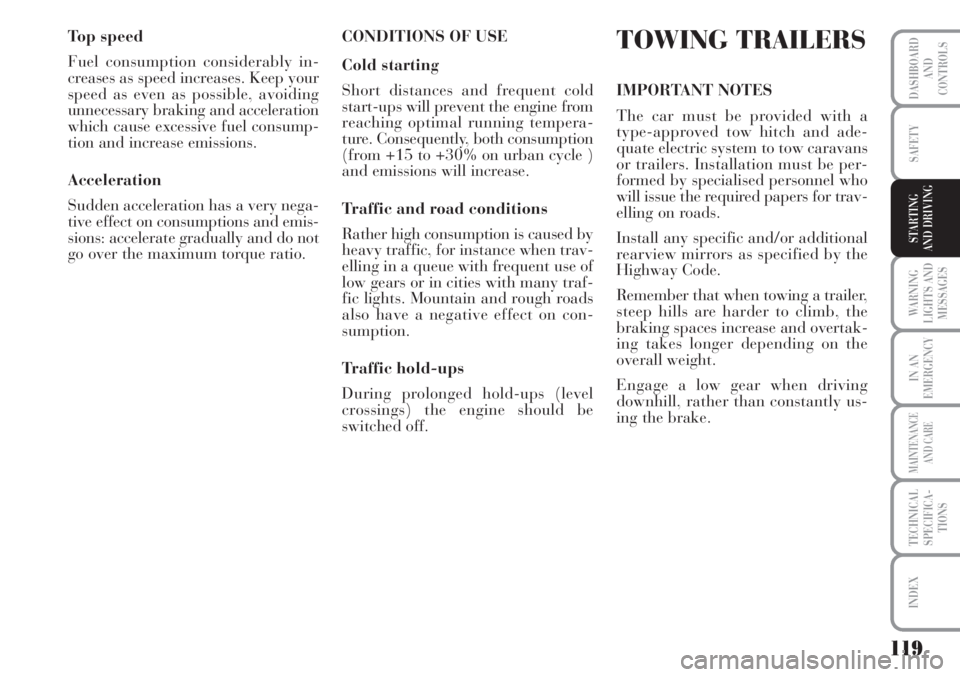
119
WARNING
LIGHTS AND
MESSAGES
IN AN
EMERGENCY
MAINTENANCE
AND CARE
TECHNICAL
SPECIFICA-
TIONS
INDEX
DASHBOARD
AND
CONTROLS
SAFETY
STARTING
AND DRIVING
Top speed
Fuel consumption considerably in-
creases as speed increases. Keep your
speed as even as possible, avoiding
unnecessary braking and acceleration
which cause excessive fuel consump-
tion and increase emissions.
Acceleration
Sudden acceleration has a very nega-
tive effect on consumptions and emis-
sions: accelerate gradually and do not
go over the maximum torque ratio.CONDITIONS OF USE
Cold starting
Short distances and frequent cold
start-ups will prevent the engine from
reaching optimal running tempera-
ture. Consequently, both consumption
(from +15 to +30% on urban cycle )
and emissions will increase.
Traffic and road conditions
Rather high consumption is caused by
heavy traffic, for instance when trav-
elling in a queue with frequent use of
low gears or in cities with many traf-
fic lights. Mountain and rough roads
also have a negative effect on con-
sumption.
Traffic hold-ups
During prolonged hold-ups (level
crossings) the engine should be
switched off.TOWING TRAILERS
IMPORTANT NOTES
The car must be provided with a
type-approved tow hitch and ade-
quate electric system to tow caravans
or trailers. Installation must be per-
formed by specialised personnel who
will issue the required papers for trav-
elling on roads.
Install any specific and/or additional
rearview mirrors as specified by the
Highway Code.
Remember that when towing a trailer,
steep hills are harder to climb, the
braking spaces increase and overtak-
ing takes longer depending on the
overall weight.
Engage a low gear when driving
downhill, rather than constantly us-
ing the brake.
Page 121 of 218
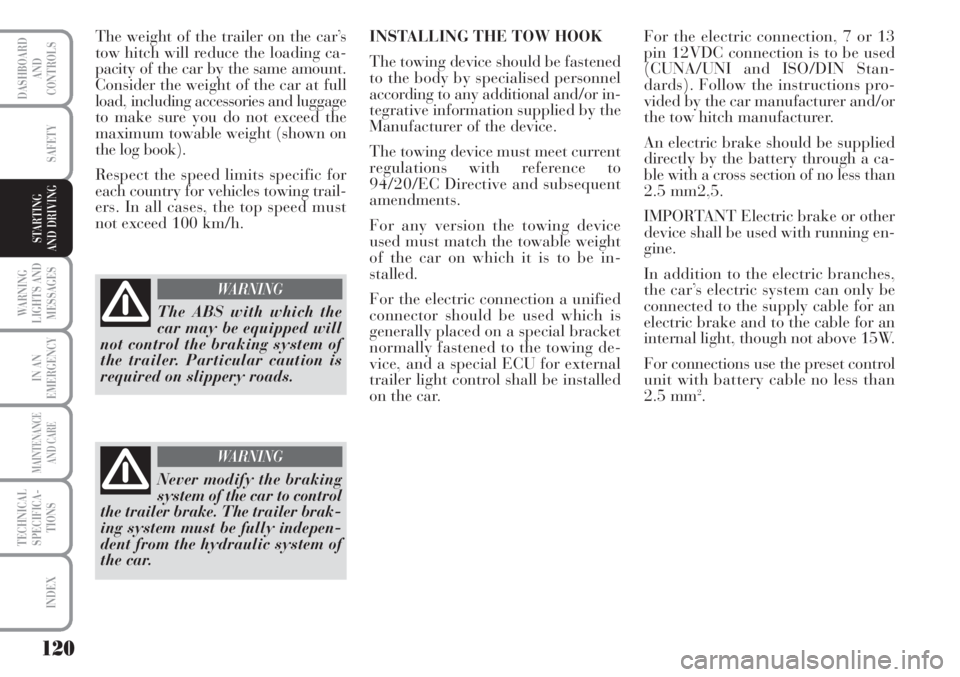
120
WARNING
LIGHTS AND
MESSAGES
IN AN
EMERGENCY
MAINTENANCE
AND CARE
TECHNICAL
SPECIFICA-
TIONS
INDEX
DASHBOARD
AND
CONTROLS
SAFETY
STARTING
AND DRIVING
The weight of the trailer on the car’s
tow hitch will reduce the loading ca-
pacity of the car by the same amount.
Consider the weight of the car at full
load, including accessories and luggage
to make sure you do not exceed the
maximum towable weight (shown on
the log book).
Respect the speed limits specific for
each country for vehicles towing trail-
ers. In all cases, the top speed must
not exceed 100 km/h.
The ABS with which the
car may be equipped will
not control the braking system of
the trailer. Particular caution is
required on slippery roads.
WARNING
Never modify the braking
system of the car to control
the trailer brake. The trailer brak-
ing system must be fully indepen-
dent from the hydraulic system of
the car.
WARNING
INSTALLING THE TOW HOOK
The towing device should be fastened
to the body by specialised personnel
according to any additional and/or in-
tegrative information supplied by the
Manufacturer of the device.
The towing device must meet current
regulations with reference to
94/20/EC Directive and subsequent
amendments.
For any version the towing device
used must match the towable weight
of the car on which it is to be in-
stalled.
For the electric connection a unified
connector should be used which is
generally placed on a special bracket
normally fastened to the towing de-
vice, and a special ECU for external
trailer light control shall be installed
on the car. For the electric connection, 7 or 13
pin 12VDC connection is to be used
(CUNA/UNI and ISO/DIN Stan-
dards). Follow the instructions pro-
vided by the car manufacturer and/or
the tow hitch manufacturer.
An electric brake should be supplied
directly by the battery through a ca-
ble with a cross section of no less than
2.5 mm2,5.
IMPORTANT Electric brake or other
device shall be used with running en-
gine.
In addition to the electric branches,
the car’s electric system can only be
connected to the supply cable for an
electric brake and to the cable for an
internal light, though not above 15W.
For connections use the preset control
unit with battery cable no less than
2.5 mm
2.
Page 122 of 218

121
WARNING
LIGHTS AND
MESSAGES
IN AN
EMERGENCY
MAINTENANCE
AND CARE
TECHNICAL
SPECIFICA-
TIONS
INDEX
DASHBOARD
AND
CONTROLS
SAFETY
STARTING
AND DRIVING
holes
load Existing
Standard ball
fig. 4
ASSEMBLY DIAGRAM fig. 4
The tow hook structure must be fastened in the points
shown by the symbol
Øusing a total of 4 M8 screws, 2
M10 screws and 2 M12 screws.
The hook should be fastened to the body avoiding any
type of drilling and trimming of the rear bumpers that re-
mains visible when the hook is removed.
IMPORTANT It is compulsory to fasten a label (plainly
visible) of suitable size and material with the following
wording:
MAX LOAD ON BALL 60 kg
After fitting, screw holes shall be sealed to
prevent exhaust gas inlet.
WARNING
L0D0256m
> 318 ± 5
Page 128 of 218
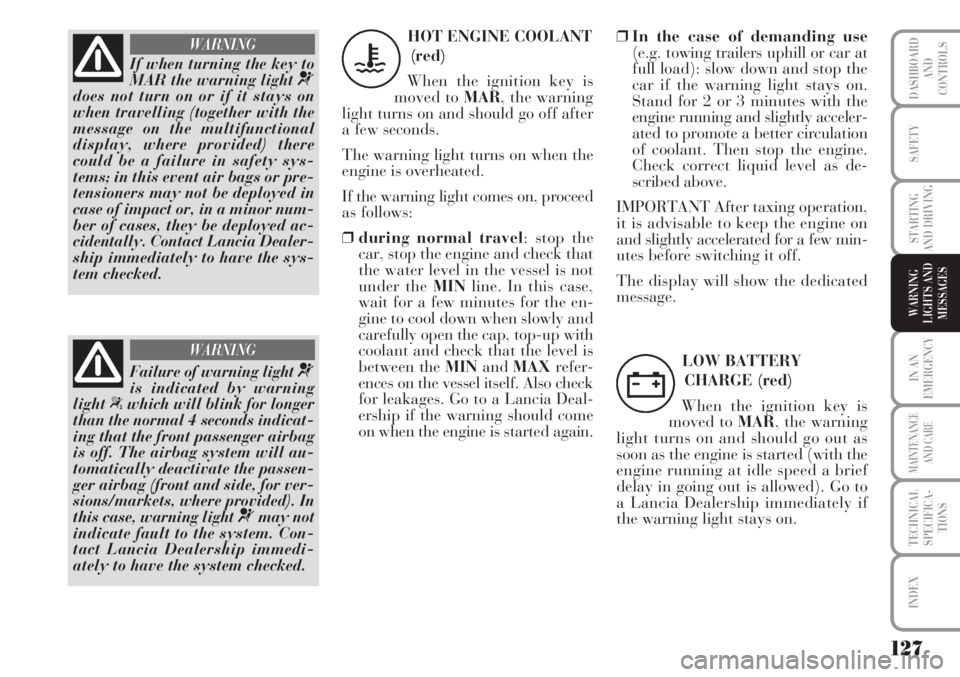
127
IN AN
EMERGENCY
MAINTENANCE
AND CARE
TECHNICAL
SPECIFICA-
TIONS
INDEX
DASHBOARD
AND
CONTROLS
SAFETY
STARTING
AND DRIVING
WARNING
LIGHTS AND
MESSAGES
If when turning the key to
MAR the warning light ¬does not turn on or if it stays on
when travelling (together with the
message on the multifunctional
display, where provided) there
could be a failure in safety sys-
tems; in this event air bags or pre-
tensioners may not be deployed in
case of impact or, in a minor num-
ber of cases, they be deployed ac-
cidentally. Contact Lancia Dealer-
ship immediately to have the sys-
tem checked.
Failure of warning light
¬is indicated by warning
light“which will blink for longer
than the normal 4 seconds indicat-
ing that the front passenger airbag
is off. The airbag system will au-
tomatically deactivate the passen-
ger airbag (front and side, for ver-
sions/markets, where provided). In
this case, warning light
¬may not
indicate fault to the system. Con-
tact Lancia Dealership immedi-
ately to have the system checked.
WARNING
WARNING
HOT ENGINE COOLANT
(red)
When the ignition key is
moved to MAR, the warning
light turns on and should go off after
a few seconds.
The warning light turns on when the
engine is overheated.
If the warning light comes on, proceed
as follows:
❒during normal travel: stop the
car, stop the engine and check that
the water level in the vessel is not
under the MINline. In this case,
wait for a few minutes for the en-
gine to cool down when slowly and
carefully open the cap, top-up with
coolant and check that the level is
between the MINandMAXrefer-
ences on the vessel itself. Also check
for leakages. Go to a Lancia Deal-
ership if the warning should come
on when the engine is started again.
u
❒In the case of demanding use
(e.g. towing trailers uphill or car at
full load): slow down and stop the
car if the warning light stays on.
Stand for 2 or 3 minutes with the
engine running and slightly acceler-
ated to promote a better circulation
of coolant. Then stop the engine.
Check correct liquid level as de-
scribed above.
IMPORTANT After taxing operation,
it is advisable to keep the engine on
and slightly accelerated for a few min-
utes before switching it off.
The display will show the dedicated
message.
LOW BATTERY
CHARGE (red)
When the ignition key is
moved to MAR, the warning
light turns on and should go out as
soon as the engine is started (with the
engine running at idle speed a brief
delay in going out is allowed). Go to
a Lancia Dealership immediately if
the warning light stays on.
w
Page 136 of 218

135
WARNING
LIGHTS AND
MESSAGES
MAINTENANCE
AND CARE
TECHNICAL
SPECIFICA-
TIONS
INDEX
DASHBOARD
AND
CONTROLS
SAFETY
STARTING
AND DRIVING
IN AN
EMERGENCY
IN AN EMERGENCY
OPENING/CLOSING THE DOORS................... 136
STARTING THE ENGINE................................ 136
Automatic FIX & GO QUICK TYRE
REPAIR KIT..................................................... 138
REPLACING A WHEEL ................................... 142
WHEN NEEDING TO CHANGE A BULB ........ 147
REPLACING EXTERIOR BULBS ..................... 150
REPLACING AN INTERIOR BULB .................. 155
REPLACING FUSES ........................................ 156
IF THE BATTERY IS FLAT .............................. 162
LIFTING THE CAR.......................................... 162
TOWING THE CAR.......................................... 163 In an emergency we recommend that you call the toll-free number found on the
Warranty Booklet. You will go to our web site at www.Lancia.com
to find the Lancia Dealership nearest to you.
Page 139 of 218
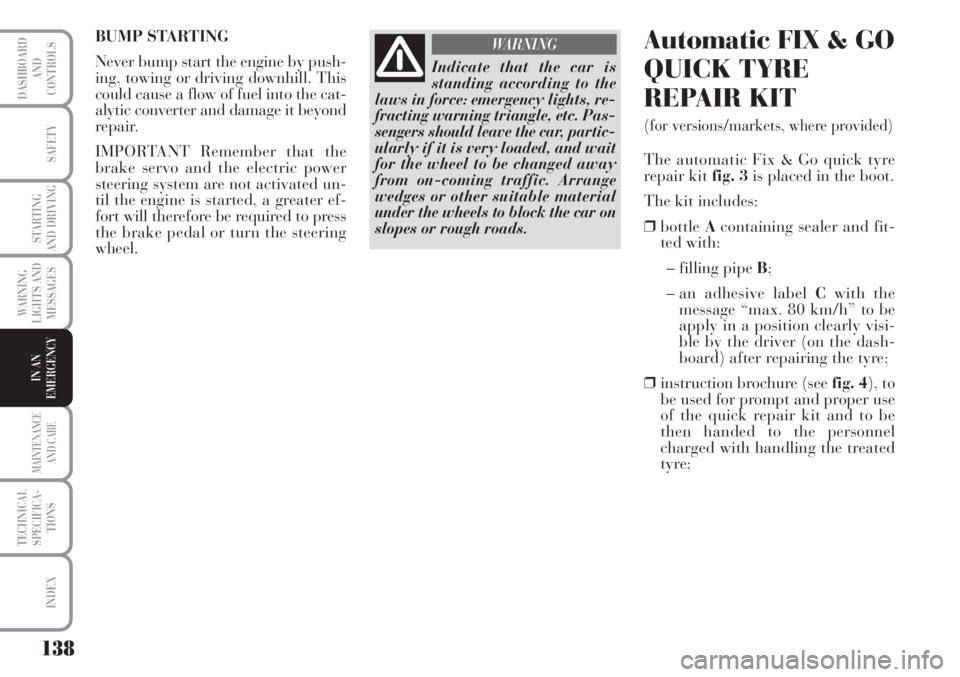
138
WARNING
LIGHTS AND
MESSAGES
MAINTENANCE
AND CARE
TECHNICAL
SPECIFICA-
TIONS
INDEX
DASHBOARD
AND
CONTROLS
SAFETY
STARTING
AND DRIVING
IN AN
EMERGENCY
BUMP STARTING
Never bump start the engine by push-
ing, towing or driving downhill. This
could cause a flow of fuel into the cat-
alytic converter and damage it beyond
repair.
IMPORTANT Remember that the
brake servo and the electric power
steering system are not activated un-
til the engine is started, a greater ef-
fort will therefore be required to press
the brake pedal or turn the steering
wheel.
Indicate that the car is
standing according to the
laws in force: emergency lights, re-
fracting warning triangle, etc. Pas-
sengers should leave the car, partic-
ularly if it is very loaded, and wait
for the wheel to be changed away
from on-coming traffic. Arrange
wedges or other suitable material
under the wheels to block the car on
slopes or rough roads.
WARNINGAutomatic FIX & GO
QUICK TYRE
REPAIR KIT
(for versions/markets, where provided)
The automatic Fix & Go quick tyre
repair kit fig. 3is placed in the boot.
The kit includes:
❒bottleAcontaining sealer and fit-
ted with:
– filling pipe B;
– an adhesive label Cwith the
message “max. 80 km/h” to be
apply in a position clearly visi-
ble by the driver (on the dash-
board) after repairing the tyre;
❒instruction brochure (see fig. 4), to
be used for prompt and proper use
of the quick repair kit and to be
then handed to the personnel
charged with handling the treated
tyre;